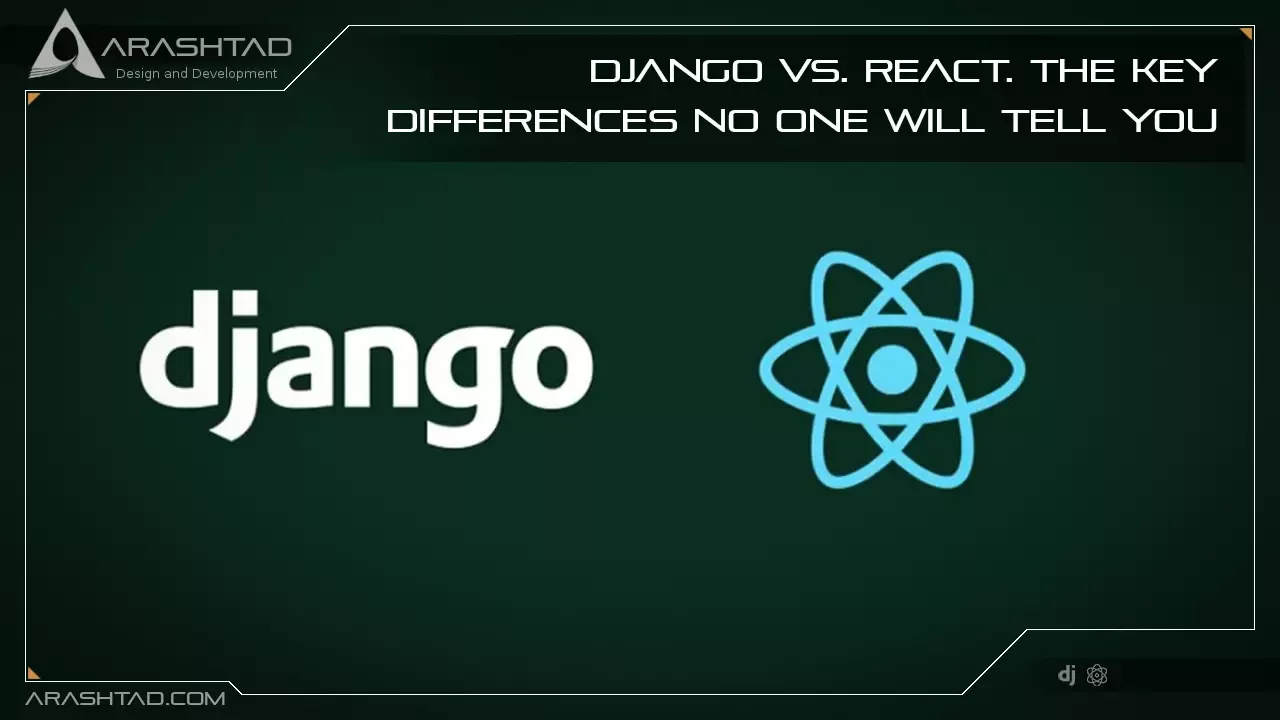Django Vs. React | The Key Differences No One Will Tell You
Choosing between React vs Django is one of the most confusing decisions a Developer makes in the early stage of their career. React focuses on Frontend and Mobile App Development, while Django focuses on Backend and Frontend Development. There are some advantages to both frameworks, but those advantages are in different fields that are valuable to developers. In this article to find out which framework is best for beginners, we’ll compare Django Vs. React.
Django
The Django Framework is a Python Web Development framework that allows Python developers to write Python code and create a custom backend with perfect security at par with modern security standards.
Perfectionists consider Django to be the Web Development framework of choice. it is fast, secure, and scalable with minimal lines of code and it is written in Python, making it easy for developers to create and deploy applications quickly with Django handling security.
Django’s steep learning curve makes it easy for developers with a basic understanding of Python to learn it. Django uses Django-Html instead of regular HTML to save developers time.
Advantages of Using Django
1. Implemented in Python
The Django App is developed in Python, which makes it easy for even a beginner to understand the code.
2. Django and Batteries
With Django, you don’t have to worry about the boring stuff since it was developed by web developers for web developers.
3. Django Means Scalable Apps
As a result, Django provides you with the freedom to make any hardware changes, and it will automatically handle it. Django is so dependable that even Instagram and Discord are using it as their backend technology.
4. Security by Django
In modern times, security means privacy for all users and their data. Thanks to the developers, all Networking and Security issues are already taken care of, so you can focus on the Development part of the framework.
Disadvantages of Using Django
1. Not suited for Smaller Projects
Django has been developed for scalability and is not intended for small projects. it comes with a huge amount of functionalities that this framework is to offer, as well as a large number of lines of code that aren’t needed for low-end websites which only require low bandwidth because Django consumes a lot of resources by default.
React
A frontend development framework called React.js is built with JavaScript to develop modern websites. JavaScript is the programming language. Most developers use React.js to develop websites with a modern look.
The React.js library was developed by Facebook’s modern name Meta with the concept of component reusability as its core value. Developers can break down a website into multiple components allowing them to focus on building complex user interfaces.
There are many big tech companies today that use React.js, including Facebook, Instagram, Netflix, and others. React is so popular that many frameworks, such as Next, are built on top of React.js. Nextjs is used by many companies, including Walmart, Codedamn, Netflix, TikTok, and even my portfolio.
Advantages of Using React.js
Due to React.js’ many advantages, most web developers in the modern world are using it over other technologies. Here are some of the advantages:
1. Faster than other Frameworks and Libraries
The React.JS library makes the complete website performant in production and it also uses VirtualDOM, allowing the UI to render components faster than Angular or Vue.JS.
2. React.js is Comparably new with Modern Features
One of the core advantages of React.js is that it comes with the latest features and security protocols inbuilt which are lacking in legacy software/Web Development. When compared with the Legacy Web Development process, performing the same task takes a long time.
3. Low Code with React
By using the component architecture in React.js, you can reduce the number of lines of code you write. you can create a component once and reuse it endlessly.
4. React.js is Lightweight
Using React JS, developers can create complex user interfaces with minimal effort by breaking their websites into multiple components.
5. Learn Once, Write anywhere
A React.js website can be developed quickly and easily, but what makes React.js even more popular is that you can also develop Mobile Apps that run on multiple platforms like Android, IOS and others with the help of React Native, which lets you learn React.js and get familiar with its environment.
Disadvantages of Using React.js
Even though React.js offers many advantages to the developer, it also has many disadvantages
1. Constantly Evolving Environment of React.js
React.js technology is a constantly evolving technology, being an Open Source library from Facebook’s current name Meta, which means a large number of developers are constantly adding code to make it more functional and high in performance.
As a result, React developers have to relearn the entire concept since React introduces major changes that make the previous concepts/tutorials over the Internet obsolete.
2. Poor Documentation
With the constant evolution of React.js, the documentation is very poorly written, as the developers are unable to maintain it with the ongoing release of the library.
Django Vs. React.js

Django Vs. React: Benefits of Django over React.js
Django offers many advantages over React.js, which are listed below:
1. Backend Development
Django has the biggest advantage over React because Backend Development is not possible with React.
2. Database Integrity
Since Django is compatible with most of the databases in production right now, it gives us an edge over React when it comes to NO-SQL databases.
3. Scalability
In terms of Frontend and Backend, Django is highly scalable. It is designed to handle any number of requests.
4. API Development
Developers can easily develop APIs in Django by using Django Rest Framework, which allows API Development with the latest security features.
5. Security
The Django framework provides security against CSRF, XSS, clickjacking, and many other Web Attacks.
6. Admin Panel
Django can easily be overtaken by React in the Frontend, however, the Admin Panel can be easily developed with Django instead of React since Django can write directly from the user and create fields directly from models.
Django Vs. React: Benifits of React.js over Django
1. Component Templating
React.js allows developers to write code for one component and provide data, and the data will be used to create multiple components automatically, saving the developer tons of time.
2. Data Storage in React.js a.k.a State Management
Despite the fact that React uses the Backend for hydrating the document, it manages its state and handles the data on its own using a plugin called Redux or inbuilt State Management.
3. Diversity with React.js
Developers can build and develop Web and Mobile Apps while Desktop Development is still in progress, with a shorter learning curve.
4. Isomorphic Apps
Initially, React was only a client-side application, which made SEO difficult, but now that it supports both client-side and server-side rendering, it has become easier to optimize.
Conclusion
In modern Web Development, JavaScript owns the field where you can do pretty much anything Web Development such as making connections with databases using Node.js, creating desktop apps with Electron.js, developing front-end websites with React, and developing mobile applications with React Native. Python has a lot of power, and by using Django, a Web Development framework built with Python, we also inherit a lot of functionality with Python’s security and approved by Web Developers.
Django and React.js are not comparable. Django Vs. React was based on functionalities and the development of apps faster. Django and React were not meant to be compared. they were designed to work together to develop high-performing applications that are secure. Ultimately, it still depends on someone’s level of experience in either of these programming languages, Python or JavaScript.

